Birds of Florida
Owls and Raptors
Barred Owl, Barn Owl, Great Horned Owl, Eastern screech owl, Red- shouldered Hawk, Bald Eagle, Crested Caracara, Osprey, Black Vulture, Turkey Vulture, Swallow-tailed Kite, American Kestrel
Barred Owl - Strix varia
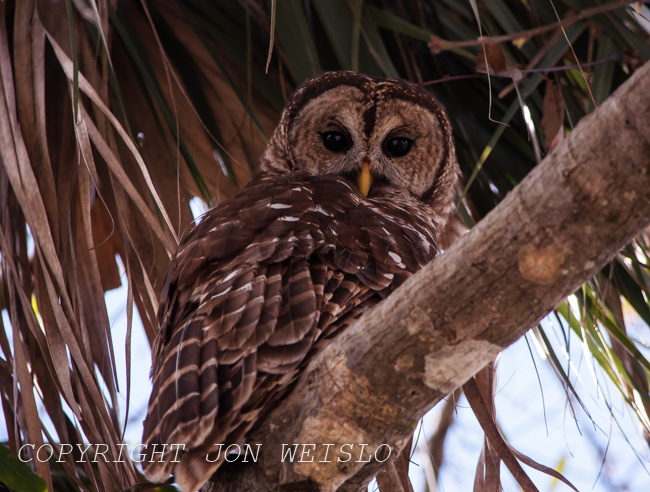
_small.jpg)
Although a nocturnal hunter, the Barred owl is often seen during the day roosting in trees. A large bird, the Barred Owl measures 21 inches long with a 3 foot wingspan.
The Barred owl has a round head with no ear tufts, is brownish-gray in color with brown and white bars across their chest and dark brown eyes.
The Barred Owl feeds on small mammals, snakes, lizards, birds and insects. Primary habitat is the woodlands around marshes, swamps, ponds, lakes.
Barn Owl - Tyto alba pratincola
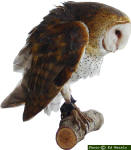
The Barn Owl is found throughout Florida and feeds primarily on rodents in open areas such as pastures, fields and prairies.
Barn owls breed from January through June, occasionally laying eggs twice in one year.
They build no real nest, laying eggs in existing tree cavities or in barns and abandoned buildings. Barn Owls may reuse a nesting site from season to season. Females are slightly larger than the males - at about 16 inches long and a little over one pound in weight.
Great Horned Owl - Bubo virginianus
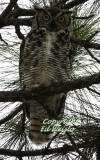
The Great Horned Owls range throughout most of North America except the most northern reaches southward into Central America. They are the largest of Florida's Owls, with a body length up to 25 inches and a wing span to five feet and is the only large owl in Florida that has ear tufts
Great Horned Owls prey on a wide variety of animals from frogs, fish and snakes to small mammals and other birds, even taking down ospreys, falcons and other owls. Capable of taking animals two or three times their own body weight, their sharp talons are strong enough to sever the spine of their prey.
Eastern Screech owl - Megascops asio
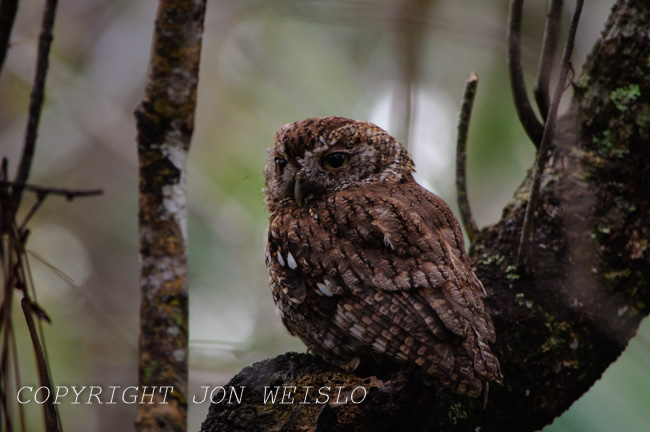
The Eastern screech owl is easy to identify by voice with an unmistakable hollow trill that can't be confused with any others. At 6 - 10 inches long with a wingspan of 18.9 - 24 inches, these little owls feed on a variety of songbirds, squirrels, rabbits, mice, insects, frogs, and lizards, some are even quite adept at catching small fish in shallow waters.
Their general habit of hunting is to swoop down on unsuspecting prey from a perch 10 - 12 feet high, they are also able to snatch insects and even bats in mid-air flight!
These owls have red, brown and gray color morphs as well as variations between red and brown. Screech owls are nocturnal the best time to see them is at dusk or early morning, during the day they tend to roost in tree nooks and cavities or among dense foliage.
Nesting is in abandoned woodpecker holes, hollow trees trunks, or woodpiles. They do not build a nest or make their own holes in trees, clutches have 2-6 white eggs, the male brings food to the female during the time she is on the nest.
Bald Eagle - Haliaeetus leucocephalus
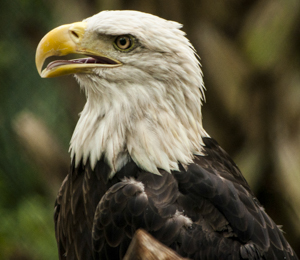
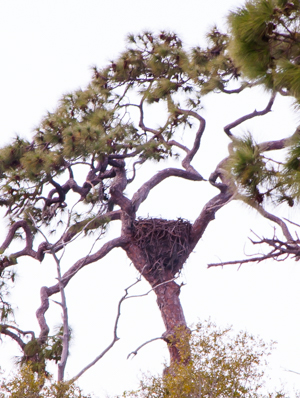
Also called the Sea eagle, these large birds with their white head and tail feathers on a chocolate-brown body are often seen perched in tree tops near bodies of water as they watch for the fish that make up a major portion of their diet. They are also well known for the habit of taking fish from Ospreys, chasing them until the Osprey drops its catch or even stealing the fish right from the Ospreys grasp! Bald Eagles will also supplement their diet with carrion if the opportunity presents itself.
Females are slightly larger than males, average mature body length is 36 inches, with a wing span up to 90 inches, or just under 8 feet. Some are year round residents to Florida while others temporarily migrate here.
Bald Eagles nests are among the largest bird nests averaging 5-6 feet in diameter and up to 4 feet high, built of sticks and twigs. Moss and grass fill in the gaps with the female doing most of the building, the inside of the nest is then lined with moss, lichen or available soft material, then with downy feathers and small bits of vegetation.
Producing one brood per year with 1-3 eggs breeding pairs stay together for life and will reuse the same nest year after year. Known for their strong flight and soaring ability, mated pairs will sometimes lock talons high up in the air, spinning and tumbling together toward the ground only releasing their embrace just before crashing to the ground.
Red- shouldered Hawk - Buteo lineatus

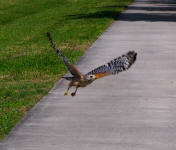
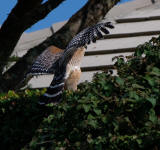
This hawk is 17 to 24 inches long with a wingspan to 44 inches and prefers bottom land and mature forests near water.
The Florida race of Red - shouldered hawk is generally paler in head and breast coloration than the northern and western varieties.
Diet consists of small mammals, birds, large insects, & snakes, it generally hunts by diving on its prey from a high perch.
Osprey - Pandion haliaetus
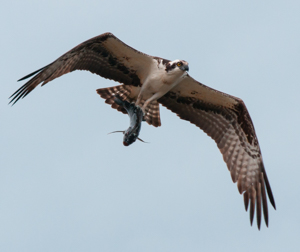

Above left - An Osprey carrying a fish / Right - A pair of Osprey on the nest
The Osprey is also known by the common name "Fish hawk", it has a body length of 24 inches with a wing span of 5-6 feet, it is a dark brown color above with a white crown and a dark eye stripe, the underside is white.
Feeding almost exclusively on live fish this bird is fairly common around estuaries, rivers and lakes. When hunting for fish an Osprey will fly with its wings held in an "M" shape, circling above the water then hovering briefly before diving on its prey, hitting the water with its legs swung forward and wings back, grasping the fish with its talons.
Lifting its prey from the water with powerful wings, the Osprey will carry a fish with the head oriented forward to a nearby perch or its nest for consumption. Ospreys have a reversible outer toe and barbed pads on their feet, two adaptations that make the Osprey such an efficient fisher.
Ospreys build a nest of sticks and twigs on a snag, at the top a tall tree, power pole or man-made platforms that have an unobstructed flight path and are high enough to discourage predators such as raccoons from the nest. Osprey produce 1 brood per season with a clutch of 1-4 eggs.
Crested Caracara - Polyborus plancus
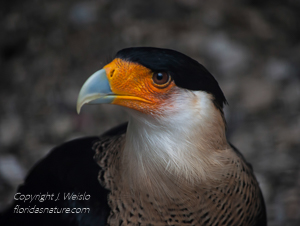
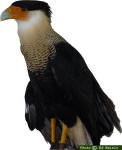
The Crested Caracara is a member of the falcon family and feeds primarily on carrion and small animals, insects and snakes, spends a great deal of time on the ground hunting.
Crested Caracara build large stick nests in trees or on the ground. Considered a threatened species in Florida, the Crested Caracara inhabits the open woodlands and prairies around Lake Okeechobee. The Crested Caracara has a body length to 24 inches with a wing span of about four feet, adult birds have yellow-orange legs, white head and neck with a black cap, a primarily black body, white breast and upper back barred with black and a blue tipped bill with orange skin showing from the eyes to the bill.
Turkey Vulture - Cathartes aura

Turkey Vultures are most notable for their red, featherless head and large size. Using their keen sense of smell and eyesight they often glide low over the landscape, seeking out carcasses and occasionally are seen feeding with groups of Black vultures.
Roosts in groups in dead trees and on fences. Turkey vultures are 24 inches long with a wingspan of 5 to 6 feet. Adults are solid black, pale silver tipped flight feathers can be seen from below, holds wings slightly above horizontal when soaring and riding thermal updrafts.
Black Vulture - Coragyps atratus
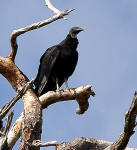
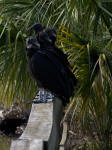
The Black Vulture is a raptor that feeds primarily on carrion but will also take down small, newborn or sick animals, fledgling birds and raid eggs from nests. Often seen feeding on road kill or perched conspicuously on dead trees, generally travels and roosts in groups.
Similar in appearance to the Turkey Vulture, they can be distinguished from them by having a black, featherless head, white tipped primary feathers and by holding its wings horizontal in a glide, whereas the Turkey Vulture has a red head and holds its wings in a "V" position when gliding.
Body length - 24 inches, wingspan is 54 inches, thick gray legs extend past the short squared off tail in flight, black in color with white tipped primary feathers, gray wrinkled bald head with a hooked beak.
Swallow-Tailed Kite - Elanoides forficatus

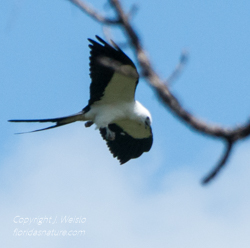
This relative of the Golden Eagle is a summer migrant to the deep south, particularly Florida. Returns to South America at summers end. The Swallow-tailed Kite is an extremely agile bird, catching flying insects in the air and picking small animals from tree tops in mid-flight as it soars along.
With a 48 inch wingspan, deeply forked tail and its sharply contrasting glossy black and bright white coloration make it really hard to mistakenly I.D. this bird!
In Florida usually seen in open pine flat-woods near marshes or prairies, cypress swamps and riverside swamps. Requires tall trees where it nests 60 feet or more off the ground with nearby open areas with plenty of prey to hunt. When hunting it will often repeatedly circle a marsh or field, criss-crossing, climbing, diving, swooping down on prey with very little (if any) wing flapping.
American Kestrel - Falco sparverius
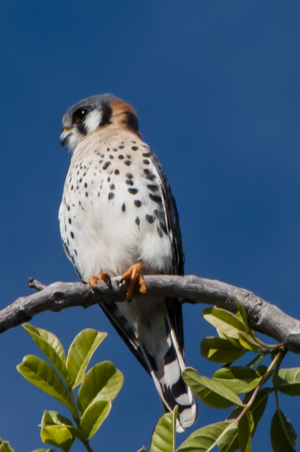
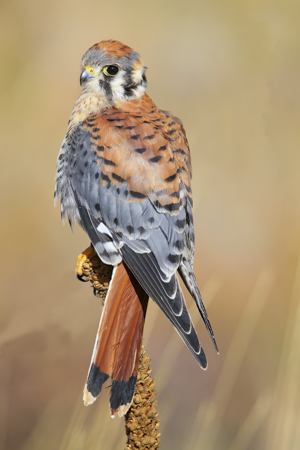
The American Kestrel or Sparrow hawk, is North America’s smallest falcon and one of the most colorful of all the raptors. Size is 8 to 12 inches in length with a wingspan of 20–24 inches or about the size of a mourning dove.
Males have a slate blue head and wings, rusty brown back and tail, females have a duller rusty colored back With a range that includes most of North America, these birds are often seen perched on utility wires or other elevated vantage points watching for prey to dive on. Diet consists of grasshoppers and other insects, voles, mice, small birds and similar sized prey.